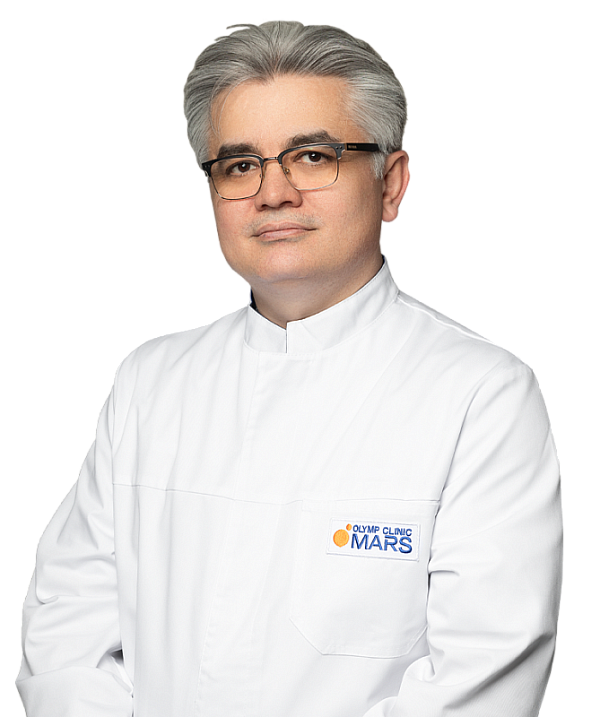Endoscopic stenosis decompression
Endoscopic stenosis decompression is a minimally invasive surgical procedure designed to relieve pressure on the spinal cord and nerve roots caused by narrowing of the spinal canal.

Various factors can cause stenosis, including degenerative changes in the spine, arthritis, intervertebral hernias, and trauma. Endoscopic decompression restores the normal amount of space around the spinal cord and nerve roots. This relieves symptoms such as pain, weakness, numbness, and limited mobility. This procedure can be performed regardless of the degree of complexity.
Before surgery, patients undergo mandatory laboratory and instrumental examinations. These tests include a complete blood count, a biochemical blood analysis, and a urinalysis. Spine X-rays and MRIs are also performed to accurately diagnose stenosis and determine its location. An electrocardiogram is necessary to identify heart conditions that could contraindicate surgery and to select optimal anesthetic drugs. The patient also receives consultations with relevant specialists, including a spine surgeon, general practitioner, and anesthesiologist.
Unlike traditional open surgery, endoscopic decompression requires only a small puncture in the skin (7-8 mm), so no large incisions are necessary. Rather than cutting the muscles, they are moved aside using a special instrument. The surgery is performed under X-ray guidance, which enables precise direction of the endoscope to the area of stenosis. A camera mounted on the endoscope transmits an image to a monitor, allowing the surgeon to perform precise manipulations. Using fine instruments, the surgeon removes the enlarged ligaments and bone spurs that are compressing the nerve roots.
We use specialized, high-resolution video equipment for endoscopic decompression that provides a clear image of the surgical site. The endoscope is equipped with cameras, a light, and irrigation channels, which offer optimal visibility and help prevent damage to critical structures. The procedure is performed using thin instruments.
Recovery after endoscopic decompression is quick. Patients typically stay in the hospital for up to 24 hours. Heavy lifting and intense physical activity should be avoided during the first few weeks. Physical and exercise therapy help speed up recovery and strengthen the back muscles. Strictly following medical recommendations is an important aspect of rehabilitation.
Benefits
Minimal invasiveness
The surgery is performed through a small puncture and does not require large incisions
Precision
The endoscope allows the surgeon to precisely control all manipulations, minimizing risks
Quick recovery
Minimal tissue trauma promotes quick recovery and a return to normal lifestyle
Pain relief
Patients report a significant reduction in pain immediately after surgery
Врачи
Смотреть всех врачейOrthopedic Trauma Surgeon, Vertebrologist
General surgeon, Professor, Doctor of Medical Sciences. Head of the Spine Surgery Department.
Similar referral activities
Scoliosis and kyphosis spine surgery (Spine straightening)
Surgical treatment for scoliosis and kyphosis is performed when the spinal curvature progresses and causes pain or impaired posture, or when the patient has a pronounced cosmetic defect. The procedure aims to restore the correct spinal alignment, address cosmetic deformities, and stabilize the spine.
Endoscopic discectomy
Endoscopic discectomy is a minimally invasive surgical procedure aimed at removing pathological disc protrusion that puts pressure on the nerve, with minimal impact on the surrounding tissue.
X-ray-guided transforaminal injection (1 zone)
X-ray-guided transforaminal injection provides targeted relief for pain caused by pinched or inflamed nerve roots in the intervertebral foramen area. This method ensures the accurate administration of drugs with minimal trauma.
Goel-Harms fixation
Goel-Harms fixation is a standard decompression and stabilization technique used for compression fractures, spinal stenosis, segmental instability, or spondylolisthesis.
X-ray-guided facet joint injection (1 spinal segment)
X-ray-guided facet joint injection is a minimally invasive procedure aimed at eliminating pain caused by inflammation or degenerative-dystrophic changes in the facet joints of the spine.
X-ray-guided knee or hip joint nerve injection
Knee or hip joint nerve block is an injection procedure that helps relieve pain caused by degenerative, inflammatory, or postoperative changes in the joints.

